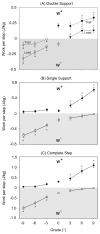Mechanical work performed by the individual legs during uphill and downhill walking
- PMID: 22099148
- PMCID: PMC3246037
- DOI: 10.1016/j.jbiomech.2011.10.034
Mechanical work performed by the individual legs during uphill and downhill walking
Abstract
Previous studies of the mechanical work performed during uphill and downhill walking have neglected the simultaneous negative and positive work performed by the leading and trailing legs during double support. Our goal was to quantify the mechanical work performed by the individual legs across a range of uphill and downhill grades. We hypothesized that during double support, (1) with steeper uphill grade, the negative work performed by the leading leg would become negligible and the trailing leg would perform progressively greater positive work to raise the center of mass (CoM), and (2) with steeper downhill grade, the leading leg would perform progressively greater negative work to lower the CoM and the positive work performed by the trailing leg would become negligible. 11 healthy young adults (6 M/5 F, 71.0±12.3 kg) walked at 1.25 m/s on a dual-belt force-measuring treadmill at seven grades (0, ±3, ±6, ±9°). We collected three-dimensional ground reaction forces (GRFs) and used the individual limbs method to calculate the mechanical work performed by each leg. As hypothesized, the trailing leg performed progressively greater positive work with steeper uphill grade, and the leading leg performed progressively greater negative work with steeper downhill grade (p<0.005). To our surprise, unlike level-ground walking, during double support the leading leg performed considerable positive work when walking uphill and the trailing leg performed considerable negative work when walking downhill (p<0.005). To understand how humans walk uphill and downhill, it is important to consider these revealing biomechanical aspects of individual leg function and interaction during double support.
Copyright © 2011 Elsevier Ltd. All rights reserved.
Conflict of interest statement
The authors have no conflicts of interest to disclose.
Figures




Similar articles
-
Advanced age affects the individual leg mechanics of level, uphill, and downhill walking.J Biomech. 2013 Feb 1;46(3):535-40. doi: 10.1016/j.jbiomech.2012.09.032. Epub 2012 Nov 1. J Biomech. 2013. PMID: 23122946 Free PMC article. Clinical Trial.
-
How does age affect leg muscle activity/coactivity during uphill and downhill walking?Gait Posture. 2013 Mar;37(3):378-84. doi: 10.1016/j.gaitpost.2012.08.004. Epub 2012 Aug 31. Gait Posture. 2013. PMID: 22940542 Free PMC article.
-
Advanced age and the mechanics of uphill walking: a joint-level, inverse dynamic analysis.Gait Posture. 2014 Jan;39(1):135-40. doi: 10.1016/j.gaitpost.2013.06.012. Epub 2013 Jul 11. Gait Posture. 2014. PMID: 23850328 Free PMC article.
-
Estimating Energy Expenditure during Level, Uphill, and Downhill Walking.Med Sci Sports Exerc. 2019 Sep;51(9):1954-1960. doi: 10.1249/MSS.0000000000002002. Med Sci Sports Exerc. 2019. PMID: 30973477 Review.
-
Contributions to the understanding of gait control.Dan Med J. 2014 Apr;61(4):B4823. Dan Med J. 2014. PMID: 24814597 Review.
Cited by
-
Fore-aft resistance applied at the center of mass using a novel robotic interface proportionately increases propulsive force generation in healthy nonimpaired individuals walking at a constant speed.J Neuroeng Rehabil. 2019 Sep 6;16(1):111. doi: 10.1186/s12984-019-0577-x. J Neuroeng Rehabil. 2019. PMID: 31492156 Free PMC article.
-
The Effects of 3 Weeks of Uphill and Downhill Walking on Blood Lipids and Glucose Metabolism in Pre-Diabetic Men: A Pilot Study.J Sports Sci Med. 2017 Mar 1;16(1):35-43. eCollection 2017 Mar. J Sports Sci Med. 2017. PMID: 28344449 Free PMC article.
-
Subject-specific responses to an adaptive ankle prosthesis during incline walking.J Biomech. 2019 Oct 11;95:109273. doi: 10.1016/j.jbiomech.2019.07.017. Epub 2019 Jul 26. J Biomech. 2019. PMID: 31431348 Free PMC article.
-
Foot and shoe responsible for majority of soft tissue work in early stance of walking.Hum Mov Sci. 2019 Apr;64:191-202. doi: 10.1016/j.humov.2019.01.008. Epub 2019 Feb 13. Hum Mov Sci. 2019. PMID: 30769210 Free PMC article.
-
Does Physical Exercise Always Improve Bone Quality in Rats?Life (Basel). 2020 Sep 23;10(10):217. doi: 10.3390/life10100217. Life (Basel). 2020. PMID: 32977460 Free PMC article. Review.
References
-
- Alexander RM. Optimum walking techniques for quadrupeds and bipeds. Journal of Zoology. 1980;192:97–117.
-
- Burnett DR, Campbell-Kyureghyan NH, Cerrito PB, Quesada PM. Symmetry of ground reaction forces and muscle activity in asymptomatic subjects during walking, sit-to-stand, and stand-to-sit tasks. Journal of Electromyography and Kinesiology. 2011;21(4):610–5. - PubMed
-
- Cavagna GA. Force platforms as ergometers. Journal of Applied Physiology. 1975;39(1):174–9. - PubMed
-
- Cavagna GA, Heglund NC, Taylor CR. Mechanical work in terrestrial locomotion: two basic mechanisms for minimizing energy expenditure. American Journal of Physiology. 1977;233(5):R243–61. - PubMed
Publication types
MeSH terms
Grants and funding
LinkOut - more resources
Full Text Sources
Research Materials

